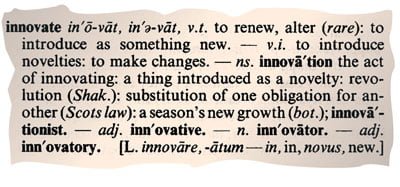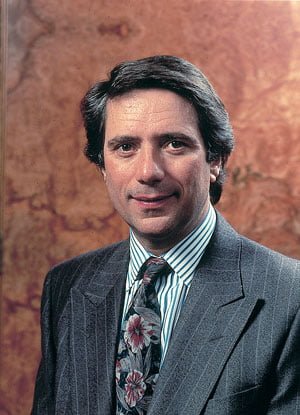
The business world is a moving target. It has changed rapidly over the last 20 years and is continuing to do so at an accelerating rate. Think of all the new industries which have developed in your lifetime – video and computer games, biotechnology, mobile telephones – all of these new products and services have developed because the technology was there and the consumer wanted it.
This has not always been the case. In the past, slower communications, and local rather than international competition, meant that companies were under less time pressure. Products changed in response to new technological developments or improvements in manufacturing processes.
‘Innovation’ …the successful exploitation of new ideas.
Modern businessmen and women face many more competitive pressures – and opportunities! The pace of change is faster. In some industries, the time taken to develop many products from the laboratory or design board to the shop shelf has been reduced from years to months. In many cases the rate of development is such that the shelf-life of a product is also very short. Just think of the pace at which new computer technology is developing!
Customers in the 1990s want newer but also better quality products. Companies, banks, service providers and manufacturers alike all now exist in a huge global marketplace. Information about the cost and quality of goods and services can be passed instantaneously between customers and alternative suppliers on different continents.
To meet these challenges, businesses and their employees must continuously create new and improved products and processes if they are to win and survive in world markets. This process of successfully exploiting new ideas is called innovation. Innovation is the cornerstone on which organisations, who wish to attain and retain success are built.
What is innovation?
Have you helped to run a Young Enterprise Company or had any work experience? Think about the shops you go to, the forms of transport you use, and the products found in your home. Which of these do you consider to be innovative and which are not? Consider what makes something innovative.
You may well have described as innovative the goods and services which most closely serve your particular needs. But your needs are never static, they change and develop over time. New trends in fashion, spending power, concerns for the environment – all influence your needs and tastes as a consumer.
To adapt to the changing concepts of customer service, companies need to develop new manufacturing or management processes in order to develop new products and services. This gives them a cutting edge over their competitors. Innovative companies are those which have a sharp customer-focus. They consider the needs and preferences of their customers to be one of the essential elements for success. The most successful companies are those which are best able to meet these changing needs.
So, what is innovation?

Firstly it is not just another word for invention. Inventions are very important because they are part of the creative process which helps to develop new ideas and products. But relatively few inventions become products (i.e. invention is about developing new ideas, about how to do things, but is not necessarily about actually doing them). Invention may be part of the process of innovation but innovation is much broader. Innovation embraces the whole spectrum of ideas, attitudes and structures within an organisation – a framework within which continuous improvement in products, services and processes can be made. Innovation is the successful exploitation of new ideas; it is the total process of developing a new concept into a new product or process which adds value to the business. This process has to be recognised and managed.
When you are a member of an organisation, never think “innovation does not involve me”. It embraces all people, the jobs they do, the systems they follow and the technology they use and is an essential part of good management. It applies as much to the school or college which you attend, the family group in which you live and any company you work for or establish yourself. Innovation is part of all business functions – research, design, development, production, purchasing, personnel, marketing, sales, distribution, servicing, training, finance and administration. It is a dynamic process which is as much a part of long-term strategy as it is part of everyday practice.
Innovation is the process of taking new ideas effectively and profitably through to satisfied customers. It is a process of continuous renewal involving the whole company, and is an essential part of business strategy and everyday practice.
Innovative people

Innovative organisations see all of their employees as a key resource. Such organisations provide every individual with an opportunity for training and continuous personal and professional development, and have a culture which enables all employees to make a contribution to the success of the company and to achieve personal fulfilment.
Innovative companies usually have a flat management structure: they are not bureaucratic and there are few management layers. Leaders who are enthusiastic champions of change are an essential component of a successful, innovative organisation. Such leaders are able to communicate their vision and their objective throughout the organisation – to “cascade it downwards”, so that everybody within the organisation expects change and welcomes it. Such leaders must be able to motivate all employees, take risks, be prepared to see others take risks and if necessary, fail. They create this innovative culture throughout the company.
Innovative organisations unlock the potential of people. This is called empowerment. People are empowered when they are encouraged to develop their skills and abilities fully and are given the level of responsibility which enables them to do so. Innovative companies provide training to enable their employees to develop new skills as well as improve on existing ones. Such organisations have often won “Investors in People” status – an award which recognises the importance they attach to the development of their main resource – their employees. Has your school or college achieved IIP status yet? Good communications are a vital element of an innovative organisation, both to share the vision and objectives, and to ensure that all employees have an opportunity to communicate their views. Communication has to be a two way process – both from the top down and from the bottom up. It is also vital so that the organisation is alive to the views and needs of its customers.
Knowing customers

Customers are the focal point of an innovative organisation. Organisations today realise that they cannot compete on the basis of their products and prices alone. Satisfying customer needs has become the major tool used by innovative organisations to compete in the rapidly changing markets of the 1990s and 21st century. In many cases a key requirement is to know the customer and the marketplace better than the customer and better than your competitors.
Innovative organisations constantly seek to provide improved products and services which aim to exceed customer expectations. Customer delight is at the heart of this process. Customers today not only want high quality, low cost, good performance and short delivery time, they also demand a high standard of customer service.
The willingness of customers to come back for repeat purchases is often dependent upon how well the organisation builds up a relationship with their customers. This is part of what is called relationship marketing – where an organisation develops its activities which take into account how they affect the relationships with their customers.
In today’s markets, innovative, customised products and services, supported by marketing and design are the differentiators that allow companies to win: (‘if the product is right, and you deliver what, when and how your customer wants, the world is your oyster’).
Stoves Ltd

‘The first thing you need to start a new company is a clear strategic plan and vision.’ John Crathorne, managing director and CEO of Stoves Ltd (producers of cookers and hobs) is quite specific about what he and his colleagues wanted to achieve through their management buy-in in May 1989. ‘We wanted to create a quality company which was capable of satisfying consumer needs in a rapidly changing market.’
The achievement of that vision makes an astonishing story. The first thing the new management team did was to research the market in detail, something which had not been done before. At that time, 85% of all built-in electric ovens were imported. The results showed that consumers were becoming increasingly sophisticated. Not only did they want a well-designed, quality product, they wanted it tailored to suit individual needs.
“In the modern kitchen, cookers are virtually the only appliance you actually see. Consumers want to have a say in their colour, size, and shape. They want a cooker which is hygienic, safe, easy to clean and geared to the food they cook, in the way they want to cook it. In other words, they want innovation, more involvement, more choice.”
In the past, engineers came up with bright ideas and the marketing department then decided how to position them. Stoves turned all this on its head. Its our plan was to identify user innovation and then satisfy it. We see this as the trend of the nineties – mass customisation. How could this idea be put into practice? The changes came in several stages. In 1989, the factory employed about 500 people; the first challenge was to communicate the strategic vision to the staff and gain their involvement. The long production line was restructured into teams of 8-10 people, each team being responsible for the whole production process.
Employees’ pay was no longer linked to volume, each person was paid a salary, in recognition of their value as one member of a company’s own training school production team. Virtually every employee was retrained at the company’s own training school on site, learning how to work more effectively as a team by tackling problem-solving tasks which were highly relevant to the work.
“You cannot be a quality company unless you believe in, and invest in, your staff. Our people know they are special.”
The current training cost is approximately £500,000 per year, for a staff of 680 people. Central to the vision of the Stoves’ management team is the relationship they have with suppliers. In 1989, Stoves had approximately 250 suppliers. They unloaded their products into a central area and the goods were then checked and either accepted or rejected. Now, things work very differently.
Suppliers as partners
‘We have 50 key suppliers and we regard them as partners, with whom we have a mutually beneficial relationship’, says John Crathorne. There has to be a high degree of trust because they are closely involved with all our new products. We believe that when two companies form this kind of partnership, they make sure they don’t let the other party down because there is too much to lose. In our factory, the person who delivers the goods identifies with the team he services. He finds out the programme for the day or week ahead and makes sure that the right material is in the right place at the right time. Each team has its own telephone for instant access and team leaders are in constant contact with suppliers. How many companies can say that they never have to give their suppliers a schedule? Or that time spent invoicing can be cut down to one transaction per month?
The factory never knows two days in advance what it will be producing, yet they produce about 1,200 units per day. They have no warehousing and very little stock. Products are produced against orders for immediate delivery. What does all this mean for the consumer? – Customised quality products, designed, produced and delivered quickly.
As for the company, the figures speak for themselves. In a market which has declined by 30% between 1989 and 1994, Stoves increased its turnover from £17 million to £42 million. Managers at Stoves are no longer ‘directors of people’, they are more ‘directors of traffic’. Their role is to ensure that the system as a whole is running smoothly and that it is supported by the appropriate resources.
“This company used to struggle to launch three new models of cooker a year. We now have the capability to launch a new model every single day of the week.”
Conclusion

This brief study has been designed to show the role of innovation in securing a firm foundation for competitive achievements. Innovation has assumed an important role for managers in helping them to improve their organisation’s competitiveness. The key message is that businesses must aim to win, with the right people and the right product, delivered at the right price, on time and supported with a superior level of service. At the same time, it must be remembered that innovative people require many skills including those of creativity as well as the ability to get things done.
